AMD Ryzen 9 5980HS Cezanne Review: Ryzen 5000 Mobile Tested
by Dr. Ian Cutress on January 26, 2021 9:00 AM EST- Posted in
- CPUs
- AMD
- Vega
- Ryzen
- Zen 3
- Renoir
- Notebook
- Ryzen 9 5980HS
- Ryzen 5000 Mobile
- Cezanne
CPU Tests: Simulation
Simulation and Science have a lot of overlap in the benchmarking world, however for this distinction we’re separating into two segments mostly based on the utility of the resulting data. The benchmarks that fall under Science have a distinct use for the data they output – in our Simulation section, these act more like synthetics but at some level are still trying to simulate a given environment.
DigiCortex v1.35: link
DigiCortex is a pet project for the visualization of neuron and synapse activity in the brain. The software comes with a variety of benchmark modes, and we take the small benchmark which runs a 32k neuron/1.8B synapse simulation, similar to a small slug.
The results on the output are given as a fraction of whether the system can simulate in real-time, so anything above a value of one is suitable for real-time work. The benchmark offers a 'no firing synapse' mode, which in essence detects DRAM and bus speed, however we take the firing mode which adds CPU work with every firing.
The software originally shipped with a benchmark that recorded the first few cycles and output a result. So while fast multi-threaded processors this made the benchmark last less than a few seconds, slow dual-core processors could be running for almost an hour. There is also the issue of DigiCortex starting with a base neuron/synapse map in ‘off mode’, giving a high result in the first few cycles as none of the nodes are currently active. We found that the performance settles down into a steady state after a while (when the model is actively in use), so we asked the author to allow for a ‘warm-up’ phase and for the benchmark to be the average over a second sample time.
For our test, we give the benchmark 20000 cycles to warm up and then take the data over the next 10000 cycles seconds for the test – on a modern processor this takes 30 seconds and 150 seconds respectively. This is then repeated a minimum of 10 times, with the first three results rejected. Results are shown as a multiple of real-time calculation.
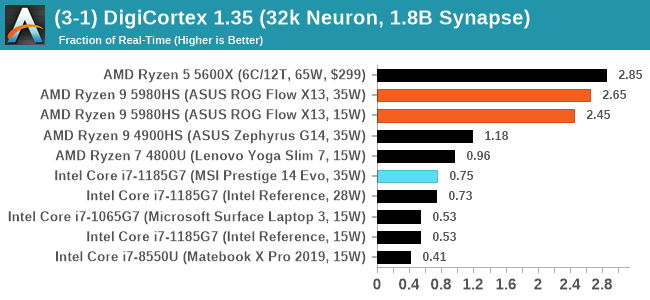
DigiCortex seems to have taken a shine to Zen 3, especially processors with a single chiplet of cores. Intel can't seem to compete here.
Dwarf Fortress 0.44.12: Link
Another long standing request for our benchmark suite has been Dwarf Fortress, a popular management/roguelike indie video game, first launched in 2006 and still being regularly updated today, aiming for a Steam launch sometime in the future.
Emulating the ASCII interfaces of old, this title is a rather complex beast, which can generate environments subject to millennia of rule, famous faces, peasants, and key historical figures and events. The further you get into the game, depending on the size of the world, the slower it becomes as it has to simulate more famous people, more world events, and the natural way that humanoid creatures take over an environment. Like some kind of virus.
For our test we’re using DFMark. DFMark is a benchmark built by vorsgren on the Bay12Forums that gives two different modes built on DFHack: world generation and embark. These tests can be configured, but range anywhere from 3 minutes to several hours. After analyzing the test, we ended up going for three different world generation sizes:
- Small, a 65x65 world with 250 years, 10 civilizations and 4 megabeasts
- Medium, a 127x127 world with 550 years, 10 civilizations and 4 megabeasts
- Large, a 257x257 world with 550 years, 40 civilizations and 10 megabeasts
DFMark outputs the time to run any given test, so this is what we use for the output. We loop the small test for as many times possible in 10 minutes, the medium test for as many times in 30 minutes, and the large test for as many times in an hour.
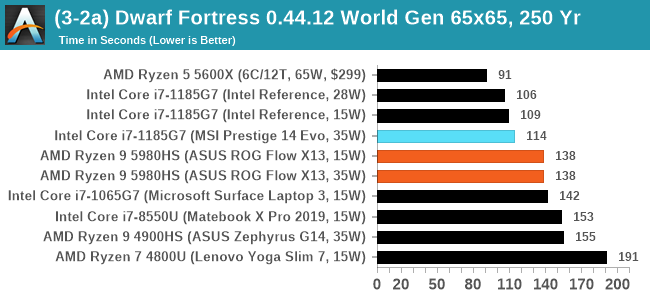
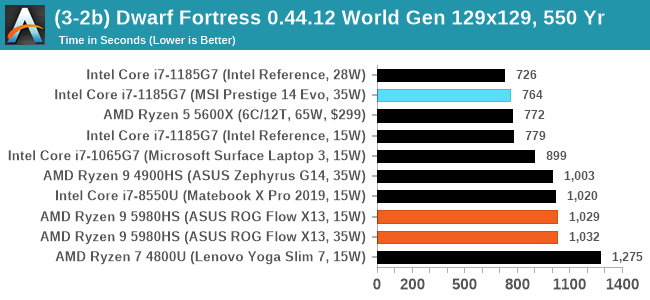
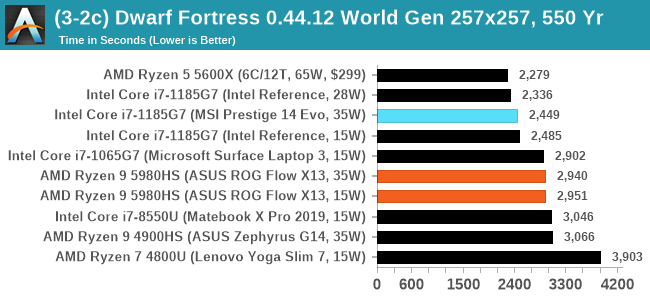
DF has historically been an Intel favorite, and we're not seeing much of a speedup for mobile Zen 3 over mobile Zen 2 here.
Dolphin v5.0 Emulation: Link
Many emulators are often bound by single thread CPU performance, and general reports tended to suggest that Haswell provided a significant boost to emulator performance. This benchmark runs a Wii program that ray traces a complex 3D scene inside the Dolphin Wii emulator. Performance on this benchmark is a good proxy of the speed of Dolphin CPU emulation, which is an intensive single core task using most aspects of a CPU. Results are given in seconds, where the Wii itself scores 1051 seconds.
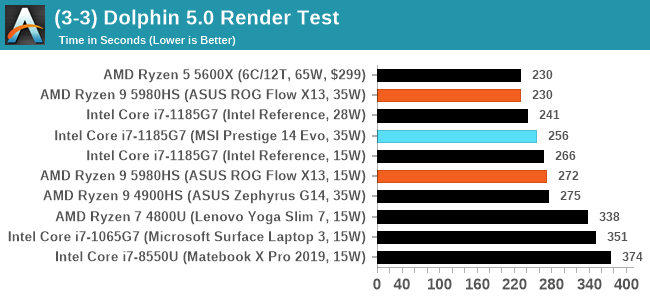
The 35W variant of Cezanne pushes through here, matching the desktop processor, and a sizeable performance jump over the previous generation Renoir.












218 Comments
View All Comments
Makste - Thursday, January 28, 2021 - link
I've revised the charts, from what I've seen, the MSI Prestige Evo 14 is configured at 35W and happens to match performance with the intel reference configured at 28W. The biggest discrepancy I have seen between the two is in the y-Cruncher benchmark. However putting this one benchmark aside, intel's reference unit doesn't seem to differ greatly in performance from the shipping intel unit in the msi prestige evo 14.Spunjji - Friday, January 29, 2021 - link
Having gone over things again more carefully, I definitely overstated things when I said "annihilate", but in the tests where they both appear the Intel reference platform at 28W is faster than the MSI Prestige at 35W more often than the other way around (16-13). When the MSI does win, it's often not by much, and there are even 7 examples where the Intel reference platform at 15W beats the MSI at 35W - usually single-thread tests.My best guess is that the Intel platform might be showing some sort of latency advantage, possibly related to how quickly it can shift between speed states - which would favour it in the shorter and/or more lightly-threaded tests. I'd love to see a detailed analysis, though - ideally with more Tiger Lake platforms, as I think the Prestige may actually be one of the fastest ones shipping.
gruffi - Thursday, January 28, 2021 - link
And people really thought that Tiger Lake's new iGPU would be superior to "old" Vega. Loses here in 6 out of 8 titles. Nice job, Intel marketing. LOL.iLloydski - Thursday, January 28, 2021 - link
Why isn't PCIe 4.0 a thing in mobile?Spunjji - Friday, January 29, 2021 - link
Power consumption and board complexity. Tiger Lake has PCIe 4.0, but only 4 lanes of it.Farfolomew - Thursday, February 4, 2021 - link
Yeah and Tiger Lake is better at power consumption too. So why again has AMD dropped the ball on adding PCIE-4? Last year it was acceptable, with Renoir, as PCIE-4 was brand new to Desktop and Intel wasn't anywhere close to releasing it, but now it feels AMD missed the bus on this one, along with not providing the now-free Thunderbolt 4 connection.jtd871 - Thursday, January 28, 2021 - link
It doesn't make high-end graphics as that cuts into the power budget and die space budget - plus they want to sell discrete mobile gpus to laptop OEMs. they'll continue to include good enough graphics, but there isn't a compelling reason for them to waste die space on a solution that isn't needed for most normal laptop use cases or that will cannibalize sales of discrete graphics.jtd871 - Thursday, January 28, 2021 - link
Replace intro above with "It doesn't make sense for AMD to put high-end graphics on-die as that cuts..."sandeep_r_89 - Friday, January 29, 2021 - link
Was that liquid metal TIM on the CPU in the picture? Did Asus actually use liquid metal TIM for a consumer product?Spunjji - Monday, February 1, 2021 - link
It sure does look like it - and would explain the insulating goop surrounding it.It's probably necessary to get the CPU's expected performance out of a device in this form factor without it constantly sounding like a tiny jet engine.